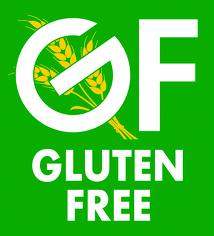by Elizabeth Barbone
 September 13 is Celiac Awareness Day! Celebrated on the birthday of Samuel Gee, the physician who, in 1888, made the connection between the celiac disease and diet, the day calls attention to what was once a little known autoimmune disease.
When someone with celiac disease eats gluten, a protein found in grains like wheat, rye, and barley, a serious immune response occurs in the small intestine. This reaction damages the villi that line the intestine walls. When villi are inflamed, absorption of key nutrients is diminished, causing malnourishment and other ailments. Symptoms of celiac disease are incredibly varied. The National Foundation for Celiac Awareness states that there are over 300 symptoms of celiac disease. Untreated celiac disease is linked to other autoimmune diseases, osteoporosis, thyroid disease, and cancer. Blood work ordered by a physician is the first step in diagnosing the disease.
Once diagnosed, a diet free from gluten remains the only cure for celiac disease. If someone with celiac consumes even the smallest amount of gluten (think: crumbs), the immune system is triggered.
However, avoiding gluten doesn’t mean avoiding whole grains! Whole-grain flours, like their gluten-filled cousins, are high in fiber and contain important nutrients. In the past, whole grain gluten-free products were tough to find and required mail order or long drives to specialty shops. This meant that many of us on a gluten-free diet stuck to the “white stuff”: rice flours and starches.
Now whole grain gluten-free products are more commonly available. Sorghum, quinoa, millet, and buckwheat flours are now shelved alongside white rice flour and whole grains are included in more commercially prepared gluten-free products.
Since everyone, whether they have celiac disease or not, should aim to consume three to five servings of whole grains per day, here are three ways to incorporate more whole grains into your gluten-free diet:
September 13 is Celiac Awareness Day! Celebrated on the birthday of Samuel Gee, the physician who, in 1888, made the connection between the celiac disease and diet, the day calls attention to what was once a little known autoimmune disease.
When someone with celiac disease eats gluten, a protein found in grains like wheat, rye, and barley, a serious immune response occurs in the small intestine. This reaction damages the villi that line the intestine walls. When villi are inflamed, absorption of key nutrients is diminished, causing malnourishment and other ailments. Symptoms of celiac disease are incredibly varied. The National Foundation for Celiac Awareness states that there are over 300 symptoms of celiac disease. Untreated celiac disease is linked to other autoimmune diseases, osteoporosis, thyroid disease, and cancer. Blood work ordered by a physician is the first step in diagnosing the disease.
Once diagnosed, a diet free from gluten remains the only cure for celiac disease. If someone with celiac consumes even the smallest amount of gluten (think: crumbs), the immune system is triggered.
However, avoiding gluten doesn’t mean avoiding whole grains! Whole-grain flours, like their gluten-filled cousins, are high in fiber and contain important nutrients. In the past, whole grain gluten-free products were tough to find and required mail order or long drives to specialty shops. This meant that many of us on a gluten-free diet stuck to the “white stuff”: rice flours and starches.
Now whole grain gluten-free products are more commonly available. Sorghum, quinoa, millet, and buckwheat flours are now shelved alongside white rice flour and whole grains are included in more commercially prepared gluten-free products.
Since everyone, whether they have celiac disease or not, should aim to consume three to five servings of whole grains per day, here are three ways to incorporate more whole grains into your gluten-free diet:
- Bake with Whole Grains
- Enjoy whole grains as a savory side dish.
- Look For Whole Grains on the Label
 3 tablespoons ground flax meal
1/4 cup hot water
5 ounces (1 1/4 cups) sorghum flour
4 ounces (3/4 cup) brown rice flour
1 teaspoon baking soda
1/2 teaspoon salt
3/4 cup soy-free shortening or coconut oil
4 ounces (1/2 cup) dark brown sugar
3 1/2 ounces (1/2 cup) granulated sugar
2 teaspoons vanilla extract
12 ounces vegan and/or allergen free chocolate chips
Center oven racks in middle position and preheat oven to 350°F. Line baking sheet with parchment paper.
In small bowl, whisk together ground flax and hot water. Set aside.
In medium bowl, whisk together sorghum flour, brown rice flour, baking soda, and salt.
In bowl of stand mixer fitted with paddle attachment (or large bowl), cream together shortening and sugars on medium high speed. Cream until a thick paste forms, about 30 seconds. Add flax mixture and vanilla. Cream until mixture is light and fluffy, about 45 seconds.
Stop mixer and scrape down bottom and sides of bowl. Add dry ingredients. Turn mixer on to medium speed. Mix until dough forms, about 30 seconds. Turn off mixer and add chocolate chips. Turn mixer on to low speed. Mix until chips are combined, about 15 seconds.
Drop dough, about one tablespoon each, onto prepared baking sheet, about two inches apart. Bake until cookies are golden brown and aromatic, about 14 minutes.
Remove pan from oven and allow cookies to cool on pan for two minutes. Using a metal spatula, transfer cookies to wire rack to cool completely. Store cookies in an airtight container for up to four days.
Makes about two dozen cookies.
At Price Chopper, you can find gluten free items throughout the store. Pick up a gluten free guide at the Guest Services desk in your store.
Elizabeth Barbone is the author of “Easy Gluten-Free Baking” and “How to Cook Gluten-Free.” She resides in Troy, NY. Contact her at glutenfreebaking.com
3 tablespoons ground flax meal
1/4 cup hot water
5 ounces (1 1/4 cups) sorghum flour
4 ounces (3/4 cup) brown rice flour
1 teaspoon baking soda
1/2 teaspoon salt
3/4 cup soy-free shortening or coconut oil
4 ounces (1/2 cup) dark brown sugar
3 1/2 ounces (1/2 cup) granulated sugar
2 teaspoons vanilla extract
12 ounces vegan and/or allergen free chocolate chips
Center oven racks in middle position and preheat oven to 350°F. Line baking sheet with parchment paper.
In small bowl, whisk together ground flax and hot water. Set aside.
In medium bowl, whisk together sorghum flour, brown rice flour, baking soda, and salt.
In bowl of stand mixer fitted with paddle attachment (or large bowl), cream together shortening and sugars on medium high speed. Cream until a thick paste forms, about 30 seconds. Add flax mixture and vanilla. Cream until mixture is light and fluffy, about 45 seconds.
Stop mixer and scrape down bottom and sides of bowl. Add dry ingredients. Turn mixer on to medium speed. Mix until dough forms, about 30 seconds. Turn off mixer and add chocolate chips. Turn mixer on to low speed. Mix until chips are combined, about 15 seconds.
Drop dough, about one tablespoon each, onto prepared baking sheet, about two inches apart. Bake until cookies are golden brown and aromatic, about 14 minutes.
Remove pan from oven and allow cookies to cool on pan for two minutes. Using a metal spatula, transfer cookies to wire rack to cool completely. Store cookies in an airtight container for up to four days.
Makes about two dozen cookies.
At Price Chopper, you can find gluten free items throughout the store. Pick up a gluten free guide at the Guest Services desk in your store.
Elizabeth Barbone is the author of “Easy Gluten-Free Baking” and “How to Cook Gluten-Free.” She resides in Troy, NY. Contact her at glutenfreebaking.com
